We get to enjoy a nice breeze, observe the color-changing of the leaves, and watch the trees drop their leaves as the season changes from summer to autumn. Autumn can present several obstacles to lash artists and your clients, the most common of which is eyelash shedding season, despite how nice the weather reduces. For the benefit of our fellow lash artists, we will address this well-known occurrence and uncover the true cause of eyelash shedding. In the lashing community, the question of exactly when is eyelash shedding season has generated some debate.
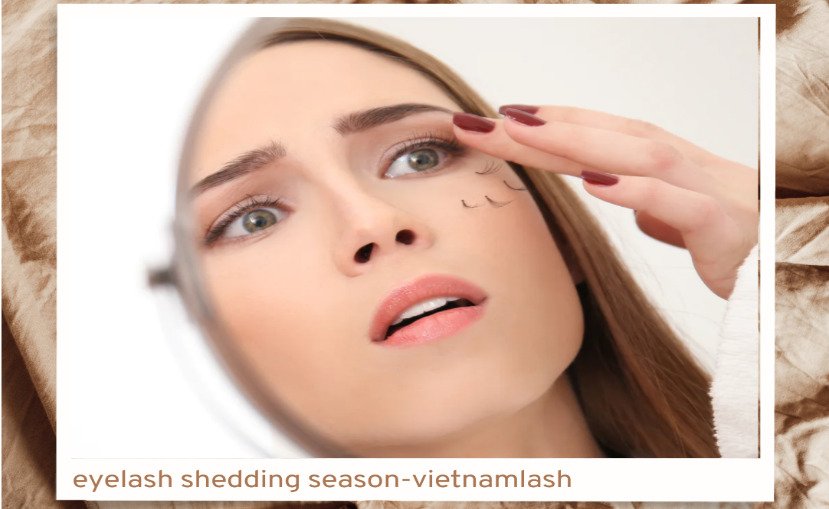
Lash growth cycle
The natural process by which eyelashes develop, pause and eventually fall out is referred to as the lash growth cycle, also known as the eyelash growth cycle. There are three major phases in this cycle:
- Anagen (Active Growth period): This is the eyelashes’ active growth period, which typically lasts 4 to 6 weeks. The lash follicles are actively growing new lashes during this stage. During this time, the lashes’ length steadily lengthens.
- Catagen (Transition Phase): The catagen phase, which lasts for around two to three weeks, is a transitional phase. The lash follicles contract during this phase and the rate of lash growth slows. The blood supply to the lashes is severed, and they stop growing.
- Telogen (Resting Phase): The telogen phase is the resting phase, lasting approximately 6 to 9 weeks. The lashes continue to be inactive throughout this stage. They have reached adulthood and are neither actively growing nor losing hair. In the follicles, new lashes start to form and push out the old ones as they do so.
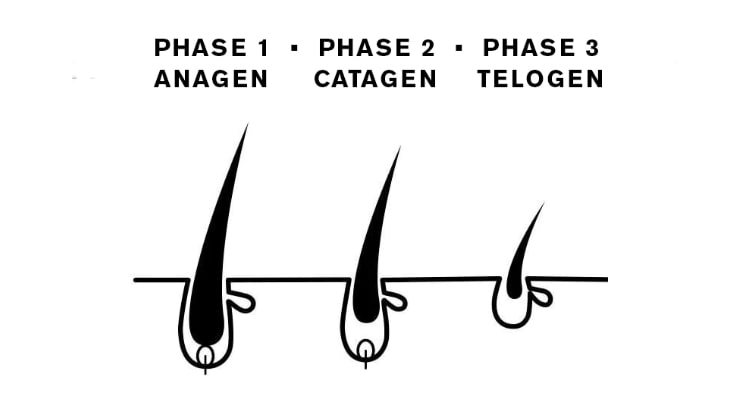
The cycle resumes after the telogen stage, and the old lashes begin to fall out on their own. People routinely lose 1 to 5 eyelashes per day, according to estimates. However, because individual eyelashes grow at different rates, it’s common to lose lashes occasionally throughout the cycle.
The lash growth cycle can be impacted by a number of variables, including age, heredity, hormonal changes, specific medical disorders, and environmental factors such as excessive rubbing or pulling. Additionally, some individuals may have differences in the length of each phase, which may have an impact on the patterns of lash growth and eyelash shedding cycle.
Read more: Is it normal for eyelash extensions to fall out?
When is eyelash shedding season?
There isn’t a set period for “eyelash shedding season” like we do for trees or plants. Throughout the year, eyelash shedding is a regular and normal occurrence. The eyelash extensions shedding is not coordinated across all lashes because each one has its own growth cycle.
As part of the typical lash growth cycle, humans typically lose 1 to 5 eyelashes per day. This natural shedding process creates space for new lashes to develop. However, extrinsic causes like prolonged eye rubbing, the use of harsh cosmetics, or certain medical procedures might hasten lash loss.
The exact cause of seasonal shedding is unclear, but some studies confirm that seasonal lash shedding occurs most often during the fall months, such as September and October.
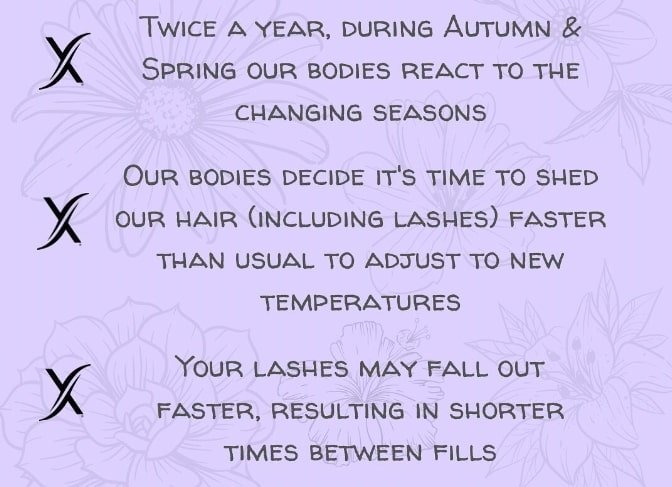
- More lash hairs may enter the telogen stage during the summer because to the intense heat, which stops further growth and shortens the lifespan. As a result, every eyelash that was “resting” during the summer is now ready to fall out over the course of the next few weeks or months in the fall.
- Because our lash line follicles produce more sweat, oil, and makeup residue in the summer than in other seasons, there is a higher chance that perspiration and dirt may clog the pores and smooth out the natural lashes. By preventing the growth of lashes during the growth phase (anagen phase), this blockage might hasten the lifecycle of the lash and result in significant lash fallout in the autumn.
It’s also important to note that eyelash shedding facts may vary slightly from person to person. For instance, seasonal weather changes, allergies, or other causes may cause some people to shed a little bit more than usual at particular periods of the year. This, however, varies from person to person and is not a universal phenomenon.
It is essential to get the counsel and examination of a healthcare professional or eye specialist if you are worried about excessive lash shedding or have any specific difficulties relating to your eyelashes.
Can you stop eyelash shedding season?
As was already mentioned, the eyelash extension shedding season is normal, and as of now, there isn’t a product on the market that can stop the cycle of natural growth and shedding. Keeping track of your growth cycle and planning your lash appointments to coincide with it is one method you can aid in increasing the retention of your lash extensions. For instance, schedule your refill right before you notice that your lash line starts to seem less full about three weeks following your session. Also, keep in mind that an infill treatment won’t be enough to restore your lashes to their former brilliance if your lash loss is greater than 50%. Make an appointment for an infill before your lashes start to look sparse. During eyelash shedding season, you may need to have more frequent infills than usual, but don’t worry; this shouldn’t last long.
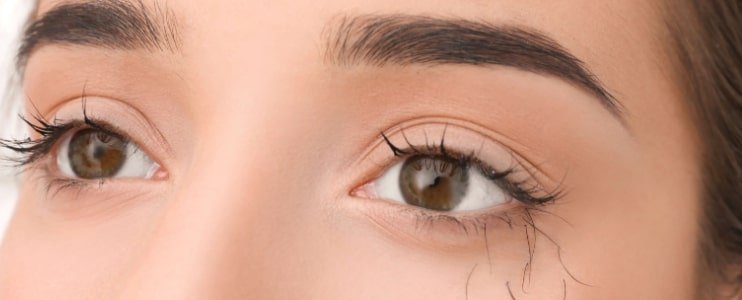
Eyelash extension care during the eyelash shedding cycle
Taking proper care of eyelash extensions during the eyelash shedding cycle is essential to maintain their longevity and minimize any potential damage. Here are some tips for caring for eyelash extensions during eyelash extensions shedding:
1. Gentle Handling: Avoid touching or rubbing your lash extensions excessively. The more you touch or pull on them, the more likely they are to prematurely fall out.
2. Avoid Oil-Based Products: Oil-based products, such as oil-based makeup removers or heavy creams, can weaken the adhesive used to attach the lash extensions. Stick to oil-free makeup removers and skincare products to preserve the longevity of your lashes.
3. Be Mindful of Water: Excessive exposure to water can weaken the lash extension adhesive, leading to premature shedding. Try to avoid direct contact with water, such as steam or heavy splashing, on your lash extensions. If they do get wet, gently pat them dry with a clean towel.

4. Skip Waterproof Mascara: Waterproof mascara can be challenging to remove and may require rubbing or tugging, which can cause lash extension damage. It’s best to avoid using waterproof mascara on your lash extensions.
5. Comb Your Lashes: Use a clean, disposable mascara wand or a lash extension brush to gently comb through your lashes daily. This helps to keep them neat, separate and prevents any tangling or clumping.
6. Sleep on Your Back: Sleeping on your back helps to minimize friction and prevents your lash extensions from rubbing against the pillow. If you’re a side sleeper, consider using a silk or satin pillowcase to reduce friction.
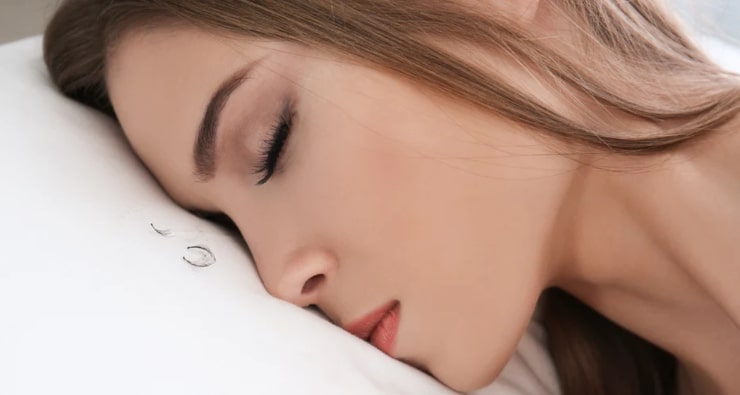
Remember, every individual’s lash shedding cycle is different, and it’s normal to lose some lash extensions during the natural process. Following these care tips and maintaining regular appointments with your lash technician will help preserve the appearance and longevity of your lash extensions during the shedding cycle.
Conclusion
We sincerely hope that this article has answered all of your questions about eyelash extensions shedding and eyelash shedding cycle! From now on, review these factors to make sure it’s not just normal shedding before criticizing your application or the glue itself.
We have MANY blog posts that can assist you if you’re having retention problems.

 +84 862 765 053
+84 862 765 053